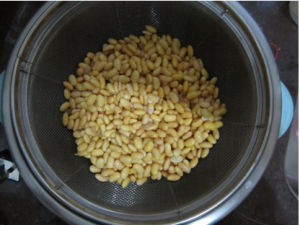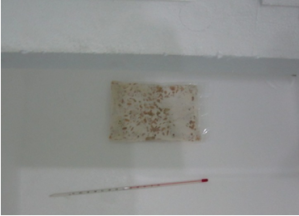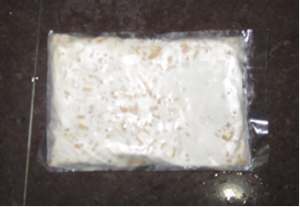What is tempeh?
Tempeh is a popular fermented
food in Indonesia and Malaysia which is rich in nutrients and active
substances. In my country, it’s one of the common foods that found in
Malay’s restaurant and hawker center.
The first time I tasted it, I
felt bit uncomfortable because of its odor smell. Actually, high
quality tempeh has a mild “mushroomy” or “yeasty” aroma, can be sliced
or cubed easily without crumbling. But, when I start to understand some
significance of soybean fermentation in tempeh on the vitamins, amino
acids, nutritional quality, functional types of microbes, and
physico-chemical properties, I begin to love it.
The flavor of soy
tempeh is full-bodied. It can be a “star” in any kitchen because it
cooks quickly and can be prepared in hundreds of ways, using all cooking
methods.
Recently, the consumption of Tempeh has been increasing
rapidly, not only in Malaysia and Indonesia but also in the United
States and Europe. Although Tempeh is not likely to be exported, the
product is consumed and produced in many countries.
The making of tempeh
Tempeh
is a fermented product made from soybeans that have been soaked and
cooked to soften them. Like sour dough bread, tempeh requires a microbes
inoculum starter, which is added to the cooked beans.
This
mixture is left for 24 hours and the result is a firm textured product
with a somewhat nutty flavor and a texture similar to a chew mushroom.
Because Tempeh is firm and it can be formed into a patty, it is used as a
substitute for animal products in what in the West is typically called
as "mock" burgers or sandwiches.
This soya product is especially
popular in Indonesia and is considered a national specialty. It has the
necessary characteristics of a dietary staple in that is high in protein
and fiber and is rich in other nutrients. It also has the advantage of
containing Vitamin B-12, which is a by-product of the fermentation
process . In this heat paper the research work carried out on tempeh
fermentation and tempeh based products is reviewed.
Role of Microorganisms in Tempeh Production:
The
type of microorganisms involved in tempeh production has been reported
by many researcher. Tempeh is the result of mixed culture fermentation
by a diverse group of microorganisms including moulds, yeasts, lactic
acid bacteria and different gram-negative bacteria. Rhizopus oligosporus is the dominant tempeh fungus although some other moulds, such as R. oryzae and Mucor spp, may also contribute to the flavour, texture or nutritive value.
A researcher named Heseltine isolated many fungi from different lots of tempeh made in Indonesia and found that only Rhizophus could make tempeh in pure culture fermentation. They also found that the 40 strains of Rhizophus studied, 25 of them are R.oligosporus others are R.stolonifier,R.arrhizus.R.oryzae, R.formosaensis and.This
finding was also confirmed by another researcher Saono , who isolated
118 cultures from 81 tempeh samples collected from markets in various
parts of Indonesia. Mulyowidarso et al also reported variable growth of bacteria during fermentation of soybeans into tempeh with R.oligosporus.
There is also another study reported that Klebsiella pneumonia was
responsible for the production of vitamin B12 in commercial tempeh.
Yeasts are frequently detected in tempeh, but their role is still
unknown
Rhizopus moulds produce natural, heat stable
antibiotic agents against some disease-causing organisms. Indonesians
who eat tempeh as a regular part of their diet recognize it as a
medicine for dysentery and rarely fall victim to the intestinal diseases
to which they are constantly exposed.
My experiment of making tempeh
1) Put
the beans in a cooking pot and add enough water to cover them. Cook
for 30 min. Drain off the water and dry the soybeans by continue heating
them in the pot on medium heat for a few minutes and until the beans
are dry. Allow the soybeans to cool down to below 35°C.
2) Sprinkle
the soybeans with 1 teaspoon of tempeh starter. Mix with a clean spoon
for about 1 minute to distribute the tempeh starter evenly. It's very
important to mix the tempeh starter very well: it reduces the risk for
spoilage and the fermentation will be faster.
3) Perforate
plastic cover with holes at a distance of about 1 cm by a thick but
sharp needle. A normal needle is too thin, you need a fat needle or
small nail (about 0.6 mm in diameter). This will allow the mould to
breathe. Divide the soybeans in the two bags and seal them. Press
them flat, making sure that the total thickness of the beans is max 3
cm.
4)Place
the packed beans in an incubator at 30°C or at a warm place for about
36- 48 hours during which the tempeh fermentation takes place.
5) Then the container was filled completely with white mycelium and the entire contents can be lifted out as a whole piece.

( Various colorful, unseen little microbes that i isolated, sub cultured and enriched from nature, BMM, and microbes-product) Hi, Dear friends, welcome to this blog. This site is a knowledge exchange platform to tell u all about the microbes and their application in our life – household, environment, food fermentation, agriculture, aquaculture, animal's and pets' health. Hope to be your frenz:) My facebook website http://www.facebook.com/ken.microbes
Subscribe to:
Post Comments (Atom)





No comments:
Post a Comment